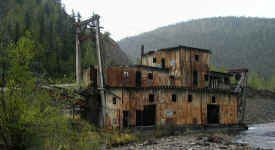Gold Dredges of the Yukon and Alaska
| Mining dredges were used in Yukon and Alaska from the turn of the century on into the 1950s to extract gold from the land. Several of these old dredges still litter the landscape of the North, one of the most visible reminders of the glory days of the Klondike Gold Rush. |
The first gold dredge appeared in the Yukon in the fall of 1899. There were eventually some 2 dozen dredges working the Klondike area. The machines allowed miners to work large amounts of ground, extracting as much gold as possible from the dwindling supply in a relatively short amount of time. But the arrival of the dredges also signaled the end of an era. Big companies who could afford to mechanize gold mining by using dredges quickly replaced the colorful stampeders with their shovels and sluice boxes that characterized the early days of the Klondike Gold Rush.
Gold dredges were used as early as 1900 on the Seward Peninsula in Alaska, but it wasn’t until 1908 that gold dredging became a financially viable option. By 1910, there were 18 dredges in Alaska. In 1914, 42 were operating throughout the state.
The mining dredges were land-locked floating machines, digging the ponds that allowed them to float—and thus move—across the area to be mined. The floating dredge most commonly operated in the North was the California-type, also known as bucket-line dredge. This type of dredge used a continuous line of buckets (called the digging ladder") to scrape the bottom and edge of the pond. The buckets carried the mud and rock to a screening area, where the heavier metal particles were separated from the rest of the material. After the metal was captured, the waste rock, or tailings, would be deposited out the back.

Gold Dredge #4
The dredges, which operated 24 hours a day, were efficient and economical. The operating season averaged 200 days, starting in late April or early May and ending in November.
It is startling to come across one of these dredges, like some mechanical behemoth silently alongside a dusty road. There are 4 good examples of gold dredges on the Klondike Loop: Gold Dredge No. 4, Jack Wade No. 1 Dredge (also known as the Butte Creek Dredge), the Mosquito Fork Dredge, and the Pedro Dredge.
Gold Dredge No. 4, a National Historic Site, is located just outside Dawson City. One of the 2 dozen dredges that worked the Klondike gold fields, today Dredge No. 4 rests alongside Bonanza Creek on Claim No. 17 (below Discovery claim), where it ceased operations in 1960.
Built in 1912, Dredge No. 4 was the largest wooden hull, bucket-line dredge in North America. It operated from 1913 until 1959 to the Klondike and Bonanza Creek valleys – the heart of the Klondike Gold Rush.
For additional information read the article Gold Dredges in the North.
